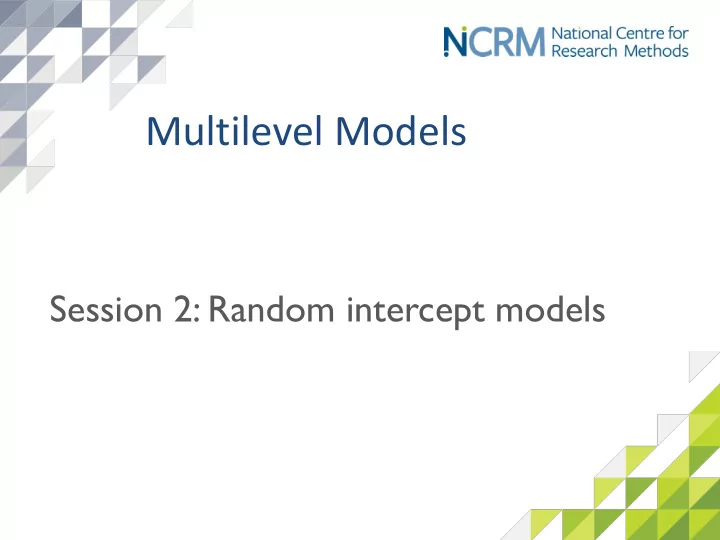

Multilevel Models Session 2: Random intercept models
Outline • Two level random intercept models – Comparing groups – the variance components model – Quantifying group differences – the variance partition coefficient – Adding predictors at the individual and group level – the random intercept model
Two level random intercept models for continuous data • Simplest form of multilevel models in wide use • Extends standard linear regression models by partitioning the residual error between individual and group components • But assumes same relationship between x and y across groups • Can provide an initial assessment of importance of groups (when no explanatory variables are included)
Single-level model for mean height = + ˆ e y e 6 i 0 i ˆ e 4 ˆ e 2 e ~ N ( 0 , ) 5 ˆ ˆ e i e 2 0 ˆ ˆ e e 7 8 ˆ e ˆ e 1 3 y i = the height for the i th individual • is residual for i th individual • e is mean height in population and 0 i (i=1,2...,n) • e Assume are approximately normal with mean 0. The variance i summarises distribution around the mean.
Single-level model for mean height ˆ 0 • But suppose we know our observations come from different groups (e.g. families), j=1,…, J shown here are two groups (in practice, there will be many more) • We can capitalise on this additional information and improve our model 5
Multi- level ‘empty’ model for mean height: variance components model = + + ˆ e ( ) y u e 41 ij 0 j ij ˆ e 21 2 u ~ N ( 0 , ) ˆ e ˆ j u 31 u ˆ e 1 11 ˆ 2 e ~ N ( 0 , ) 0 ij e ˆ u ˆ e ˆ e 2 32 42 ˆ e ˆ 12 e 22 group 1 has above-average mean (positive u) group 2 has below-average mean (negative u) - height for the i th individual in j th group (1,2,...n). • y ij • - average height across all groups 0 • u - group mean deviations from overall mean height j • e - individual deviations from group means ij + • u - average height in group j 0 j
Variance Partition Coefficient 2 = u VPC + 2 2 u e • VPC tells us how important group level differences are (e.g. what proportion of variance is at the group level?) = 2 0 • VPC = 0 if no group effect u = 2 0 • VPC =1 if no within group differences e 7
Example: Fear of Crime across neighbourhoods VARIANCE COMPONENTS MODEL Fear of crime: higher scores mean MODEL 1 more fear FIXED PART Intercept 0.027 (.009) • 27,764 individuals, nested in 3,390 areas RANDOM PART • Mean of 8 residents per area (1- 2 Individual variance 0.863 (.008) 47) e 2 Neighbourhood variance 0.145 (.007) u Crime Survey for England and Wales, 2013/14 2 = u VPC + 2 2 u e Neighbourhood contribution = .145/(.863+.145) = 14.4%
Adding an explanatory variable: A random intercept model ˆ ˆ + x ˆ 0 1 i 1 = + + + y x u e ij 0 1 ij j ij ˆ ˆ 2 1 u ~ N ( 0 , ) 1 j u ˆ u 1 2 e ~ N ( 0 , ) ij e ˆ u 2 • Overall relationship between weight and height across families is represented by intercept and 0 slope (fixed part) 1 + • u For group j, the intercept is (either above or below average) 0 j • e u Individual deviations from group line and group deviations from average line (random ij j 2 2 part, with means 0 and variances and ) e u
Group level explanatory variables • Multilevel models enable us to explore group level variables simultaneously with individual • Can be from external sources (administrative data etc), or aggregates of individual data (depending on group size) • No need to directly identify them as group effects, this is accounted for by the group residual • Standard errors generally underestimated if included in individual level analysis 10
Example: Fear of Crime across neighbourhoods RANDOM INTERCEPT MODEL Crime Survey for England and Wales, 2013/14 MODEL 1 MODEL 2 FIXED PART Intercept 0.027 (.009) -.005 (.009) x 1 ij Age (in years) -.004 (.001) x 2 ij Victim in last 12 months .248 (.014) x 3 j Crime Rate .227 (.012) RANDOM PART 2 Individual variance 0.863 (.008) .850 (.008) e 2 Neighbourhood variance 0.145 (.007) .105 (.006) u • Individual level R 2 : (.863 - .850)/.863 = .015 • Neighbourhood level R 2 = (.145-.105)/.145 = .276
Summary • In this session we have introduced the variance components model and the random intercept model • The variance components model can be used to provide an initial estimate of the contribution of groups • The random intercept model allows us to include explanatory variables at the individual and group level to explain variation in our dependent variable
Useful websites for further information • www.understandingsociety.ac.uk (a ‘biosocial’ resource) • www.closer.ac.uk (UK longitudinal studies) • www.ukdataservice.ac.uk (access data) • www.metadac.ac.uk (genetics data) • www.ncrm.ac.uk (training and information)
Recommend
More recommend